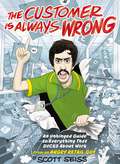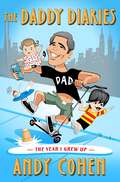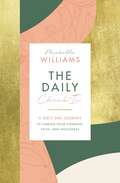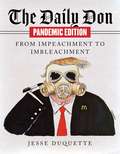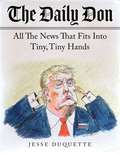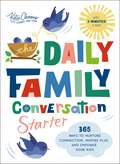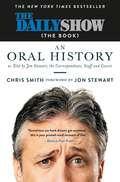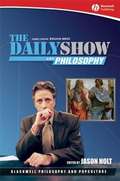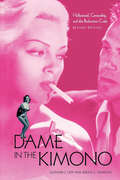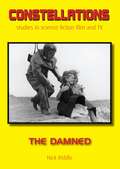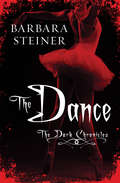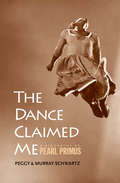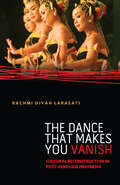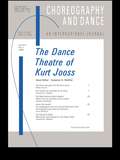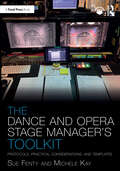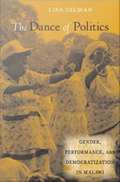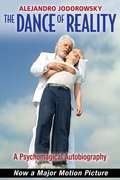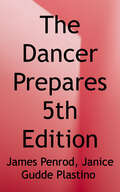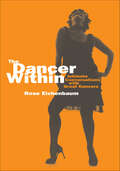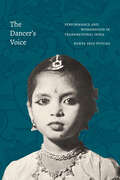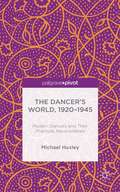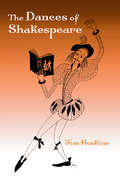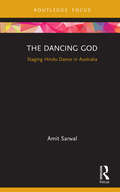- Table View
- List View
The Customer Is Always Wrong: An Unhinged Guide to Everything That Sucks About Work (from an Angry Retail Guy)
by Scott SeissGive the gift of funny to anyone in your life (maybe even yourself!) who could use a dose of irreverent humor about why work stinks.Customers want you to magically produce something from the back room. Bosses schedule you on your day off. Corporate policies are mandated that make zero practical sense. Sound familiar?If you've ever worked in customer service (or any job, really), you know that everyone else—the customer, the boss, the company—is always right, and never the employee. Well, lucky for you, the "Angry Retail Guy" is more furious—and funnier—than ever in this hilariously unhinged guide to all the things we wish we could say out loud at work . . . without getting fired. In The Customer Is Always Wrong, you'll laugh (and maybe cry) at this rant-filled, illustrated attack on all the frustrating things that suck about work.Expanding on the ire-filled, laugh-out-loud viral videos that have made him a (whispered) workplace name, Scott Seiss joyfully eviscerates not only overbearing customers but every annoying aspect of work like purposeless job interview questions, debatable brand values, and the walking human trainwrecks that are our bosses. Scott guides you all the way from first applying to the job, to inevitably gritting your teeth and smiling on your last day when that one manager you despise says, &“Come back and visit us!&”The Customer Is Always Wrong is for anyone who:Is tired of their "raise" being as close as scientifically possible to 0 percentWants to tell their boss that not even the self-checkout machines want to work hereIs prepared to tell the next customer who asks to see the manager that the manager has no idea what's going on eitherCalls in sick whenever their PTO request is deniedBelieves entering a store five minutes before it closes should be illegalExplains, on a weekly basis, why someone can't use a coupon that expired 17 years agoIs physically repulsed by the phrase, "At this company, we're a family. . . ." This tongue-in-cheek commiseration for workers will make you laugh out loud at the things that drive you crazy in the workplace. With Scott's signature rants, funny anecdotes, and absurd musings, this book celebrates and empowers underpaid and overworked employees with an uproarious, illustrated ode to what we really think about our jobs and the customers that come with them (except the ones who read this book, of course).
The Daddy Diaries: The Year I Grew Up
by Andy CohenThe Instant New York Times Bestseller!New York Times bestselling author Andy Cohen goes from bottle service to baby bottles in a hilarious, heartwarming, and name-dropping account of the most important year of his life.Andy Cohen has taken on the most important job of his life—father— and boy (and girl!) does he have a lot to say about it!One of Andy Cohen’s most momentous years starts off with a hangover the morning after an epic New Year’s Eve broadcast. But Andy doesn’t have time to dwell on the drama, as his role as media mogul is now matched with the responsibilities, joys, and growing pains of parenthood.This fast-paced, mile-a-minute look behind the scenes of living the so-called glamorous life in Manhattan now takes firm aim at life at home. With a three-year-old son, Ben, and a daughter, Lucy, born in May, stories of late-night parties are replaced by early mornings with Ben, drama at the play-ground, and the musings of a single dad trying to navigate having it all. All this is set against the backdrop of constant Housewives drama, hijinks behind the scenes at Watch What Happens Live, a revolving door of famous faces, and a worried mother (and newly minted grandmother) in St. Louis.Buckle up, bottle up, and get ready for a laugh-out-loud and surprisingly poignant look at the ways in which family changes everything and the superficial gets very real. Watch what happens!
The Daily Check-In: A 60-Day Journey to Finding Your Strength, Faith, and Wholeness
by Michelle WilliamsIn The Daily Check-In, singer and actress Michelle Williams helps readers process the emotions that cause them to feel overwhelmed and gives them powerful strategies for discovering freedom and wholeness.In her book Checking In, Michelle Williams shared the painful seasons of struggle that left her feeling like she couldn't go on. In the midst of her wrestling, she came to realize her crucial need for connection--with God, herself, and others--and developed strategies for checking in with each.Her life-giving strategies have helped her overcome the thoughts and emotions that once threatened to derail her. Now she shares those strategies with readers who are on their own journeys toward mental wholeness--and who want to discover how to be free to live an abundant life.In this sixty-day guided journal, Williams leads readers through the process of identifying the thoughts, emotions, and behaviors that leave them feeling overwhelmed, unfulfilled, and alone. Through her unique blend of tender, sometimes humorous, and often thought-provoking wisdom, Williams shows readers how to overcome difficult circumstances and relationships with life-giving honesty and connection, offeringpowerful readings about overwhelming emotions and healing from hurt;key scriptures that emphasize the importance of checking in with God, themselves, and others;journaling prompts for personal processing; andshort prayers to help readers lean on God for insight, strength, and courage on their journey toward mental wholeness.
The Daily Don Pandemic Edition: From Impeachment to Imbleachment
by Jesse DuquetteThe NEW Daily Don Pandemic Edition, political cartoon skewers the 45th with brilliant comic satire that covers the (hopefully) final two years of the Trump presidency. With the.daily.don&’s Instagram followers reaching 80,000, Jesse Duquette proves his brilliant cartoon accounts of the brutal Trump administration hit home. It began in the wake of the first Trump press conference that gave us the first &“Alternative Fact&” about inauguration crowd sizes and has continued daily, acting as a bizarre history, illustrating each daily outrage by Donald Trump. Picking up where the first book—The Daily Don: All the News that Fits into Tiny, Tiny Hands—left off, The Daily Don Pandemic Edition takes us from Trump&’s blatant attempt to cover up Russia&’s involvement in the 2016 election to his recommendation that Americans ingest disinfectant to cure coronavirus, and beyond. While Trump continues to shock and horrify on a daily, sometimes hourly, basis, Duquette keeps up with the outrageous sputter that shoots out of the president&’s mouth and perhaps other orifices with scathing satire that&’s both hilarious and, well, sad. This Pandemic Edition pulls together selections from Trump&’s (hopefully) last two-years in office and acts, again, as a semi-accurate record of what these strangest of strange times were like for those of us who were there and lived to tell the tale. Because there is still no better method to record a cartoon presidency than with colored pencils and markers.
The Daily Don: All the News That Fits into Tiny, Tiny Hands
by Jesse DuquetteThe Best of “The Daily Don,” political cartoon that documents all the covfefe of the administration of Donald Trump.The Daily Don is the best of artist Jesse Duquette’s fabulous Instagram gallery of political cartoons relating to the Trump administration. It began in the wake of the first Trump press conference that gave us the weird and unnecessary lie about crowd sizes. Right then, Jesse thought, if this was Day One and the lying was already this casual and obvious, what did this mean for Day 2? or Day 100? He drew his first picture: Sean Spicer delivering his line (“Period.”), added a quote from Orwell’s “1984” that seemed particularly relevant, and posted it to Instagram with the caption that he was going to attempt to document every day of the Administration until the end—a vow that he was maybe 35% serious about. But he has not missed a day and is still going strong. These drawings are the perfect antidote to the cries about “Fake News!” and “Build a Wall!” They help us all stay sane and smile (however nervously) through these strange times. This book pulls together selections from the first nearly-two-years in office—from Muslim bans to Melania jackets and all the beef-tweeting covfefe in between—and acts as a semi-accurate record of what these strangest of strange times were like for those of us who were there and lived to tell the tale. Because what better method to record a cartoon presidency than with colored pencils and markers?
The Daily Family Conversation Starter: 366 Ways to Nurture Connection, Inspire Play, and Empower Your Kids (Ideas for Questions and Activities that Build Better Relationships and Create Memories)
by Katie ClemonsDiscover how to strengthen your family bond and create memories that last a lifetime.Your stronger family connection starts here with just 5 minutes of conversation each day. The Daily Family Conversation Starter contains 365 easy and imaginative ways to check in with your kids, develop deeper relationships, and get both serious and silly—together! Every interactive activity and open-ended conversation prompt will help you build the family bond you've always dreamed of.Prompts like these will get your family talking—and you may find it hard to get them to stop!Who made you laugh today?What would you do if you had a tail?Why do you think it's important to try new things, even if it means you get knocked down?In addition to engaging conversation starters, you'll find inside:Easy activities for working togetherFill-in-the-blank questions that everyone can answerSpontaneous games that infuse whimsy into your family's daily routineMini essays to help your family discuss difficult topics or new concepts Whether commuting together, sitting at the dinner table, or preparing for bedtime, The Daily Family Conversation Starter invites you to share, discover, and laugh together as you create family memories that last a lifetime.
The Daily Show (The Book): An Oral History as Told by Jon Stewart, the Correspondents, Staff and Guests
by Jon Stewart Chris Smith<P>The complete, uncensored history of the award-winning The Daily Show with Jon Stewart, as told by its correspondents, writers, and host. <P>For almost seventeen years, The Daily Show with Jon Stewart brilliantly redefined the borders between television comedy, political satire, and opinionated news coverage. It launched the careers of some of today's most significant comedians, highlighted the hypocrisies of the powerful, and garnered 23 Emmys. Now the show's behind-the-scenes gags, controversies, and camaraderie will be chronicled by the players themselves, from legendary host Jon Stewart to the star cast members and writers-including Samantha Bee, Stephen Colbert, John Oliver, Steve Carell, Lewis Black, Jessica Williams, John Hodgman, and Larry Wilmore-plus some of The Daily Show's most prominent guests and adversaries: John and Cindy McCain, Glenn Beck, Tucker Carlson, and many more. <P>This oral history takes the reader behind the curtain for all the show's highlights, from its origins as Comedy Central's underdog late-night program hosted by Craig Kilborn to Jon Stewart's long reign to Trevor Noah's succession, rising from a scrappy jester in the 24-hour political news cycle to become part of the beating heart of politics-a trusted source for not only comedy but also commentary, with a reputation for calling bullshit and an ability to effect real change in the world. <P>Through years of incisive election coverage, Jon Stewart's emotional monologue in the wake of 9/11, his infamous confrontation on Crossfire, passionate debates with President Obama and Hillary Clinton, feuds with Bill O'Reilly and Fox, the Indecisions, Mess O'Potamia, and provocative takes on Wall Street and racism, The Daily Show has been a cultural touchstone. Now, for the first time, the people behind the show's seminal moments come together to share their memories of the last-minute rewrites, improvisations, pranks, romances, blow-ups, and moments of Zen both on and off the set of one of America's most groundbreaking shows. <P><b>A New York Times Bestseller</b>
The Daily Show and Philosophy: Moments of Zen in the Art of Fake News
by Jason HoltThis book brings together nineteen essays on the many moments of Zen to be found in the artful humor of The Daily Show and The Colbert Report.
The Dame in the Kimono: Hollywood, Censorship, and the Production Code
by Leonard J. Leff Jerold L. Simmons“This excellent, lively study examines the ‘raucous debate’ sparked by the Code over the morals and ideals of American movies.” —Publishers WeeklyThe new edition of this seminal work takes the story of the Production Code and motion picture censorship into the present, including the creation of the PG-13 and NC-17 ratings in the 1990s.Starting in the early 1930s, the Production Code Director, Joe Breen, and his successor, Geoff Shurlock, understood that American motion pictures needed enough rope—enough sex, and violence, and tang—to lasso an audience, and not enough to strangle the industry. To explore the history and implementation of the Motion Picture Production Code, this book uses 11 movies: Dead End, GoneWith the Wind, The Outlaw, The Postman Always Rings Twice, The Bicycle Thief, Detective Story, A Streetcar Named Desire, The Moon Is Blue, The French Line, Lolita, and Who’s Afraid of Virginia Woolf? The authors combine a lively style with provocative insights and a wealth of anecdotes to show how the code helped shape American screen content for nearly 50 years.“A readable, intimate account of the rise to near-tyrannical power, and the fall to well-deserved ignominy, of the old Production Code Administration.” —Atlantic Monthly“A valuable insight into our own innocence and naiveté.” —The New York Times Book Review“The triumph of Leff and Simmons’s fine work is that they have reminded us of how fatuous and inimical a code of conduct can be: how tempting it is as a theoretical answer, and how intrinsically flawed it is as a working solution.” —The Times of London
The Damned (Constellations)
by Nick RiddleThe Damned (1963) is the most intriguing of director Joseph Losey’s British "journeyman" films. A sci-fi film by a director who hated sci-fi; a Hammer production that sat on the shelf for over two years before being released with almost no publicity as the second half of a double bill. Losey was a director vocal in his dislike of depictions of physical violence, but he often made films that radiate an energy produced by a violent clash of elements. The Damned catches a series of collisions—some of them inadvertent—and traps them as if in amber. Its volatile elements include Losey the blacklisted director, Hammer the erratic British studio, Oliver Reed the 'dangerous' young actor, and radioactive children. Nick Riddle’s contribution to the Constellations series concentrates on historical and cultural context, place, genre, and other themes in order to try to make sense of a fascinating, underappreciated film.
The Dance (The Dark Chronicles #1)
by Barbara SteinerIs there something sinister about Madame Leona&’s dance troupe?When Melanie Clark&’s best friend, Pauline, dies in a car crash, the police write it off as an accident, but Melanie isn&’t so sure. Pauline was acting strange in the weeks before she died, and Melanie believes Pauline&’s dance teacher, Madame Leona, may have had something to do with that. In order to learn more about the mysterious hold Madame Leona has on her students, Melanie joins the teacher&’s prestigious dance group. She&’s determined to find out the truth behind Pauline&’s death—no matter what it takes. But as she becomes more involved, Melanie starts to forget why she joined in the first place, falling deeper and deeper under Madame Leona&’s spell. Can Melanie escape the woman&’s magnetic grip, or has she lost herself forever?
The Dance Claimed Me: A Biography of Pearl Primus
by Murray Schwartz Peggy SchwartzPearl Primus (1919-1994) blazed onto the dance scene in 1943 with stunning works that incorporated social and racial protest into their dance aesthetic. In The Dance Claimed Me, Peggy and Murray Schwartz, friends and colleagues of Primus, offer an intimate perspective on her life and explore her influences on American culture, dance, and education. They trace Primus's path from her childhood in Port of Spain, Trinidad, through her rise as an influential international dancer, an early member of the New Dance Group (whose motto was "Dance is a weapon"), and a pioneer in dance anthropology. Primus traveled extensively in the United States, Europe, Israel, the Caribbean, and Africa, and she played an important role in presenting authentic African dance to American audiences. She engendered controversy in both her private and professional lives, marrying a white Jewish man during a time of segregation and challenging black intellectuals who opposed the "primitive" in her choreography. Her political protests and mixed-race tours in the South triggered an FBI investigation, even as she was celebrated by dance critics and by contemporaries like Langston Hughes. For The Dance Claimed Me, the Schwartzes interviewed more than a hundred of Primus's family members, friends, and fellow artists, as well as other individuals to create a vivid portrayal of a life filled with passion, drama, determination, fearlessness, and brilliance.
The Dance That Makes You Vanish: Cultural Reconstruction in Post-Genocide Indonesia (Difference Incorporated)
by Rachmi Diyah LarasatiIndonesian court dance, a purportedly pure and untouched tradition, is famed throughout the world for its sublime calm and stillness. Yet this unyieldingly peaceful surface conceals a time of political repression and mass killing. Between 1965 and 1966, some one million Indonesians—including a large percentage of the country&’s musicians, artists, and dancers—were killed, arrested, or disappeared as Suharto established a virtual dictatorship that ruled for the next thirty years. In The Dance That Makes You Vanish, an examination of the relationship between female dancers and the Indonesian state since 1965, Rachmi Diyah Larasati elucidates the Suharto regime&’s dual-edged strategy: persecuting and killing performers perceived as communist or left leaning while simultaneously producing and deploying &“replicas&”—new bodies trained to standardize and unify the &“unruly&” movements and voices of those vanished—as idealized representatives of Indonesia&’s cultural elegance and composure in bowing to autocratic rule. Analyzing this history, Larasati shows how the Suharto regime&’s obsessive attempts to control and harness Indonesian dance for its own political ends have functioned as both smoke screen and smoke signal, inadvertently drawing attention to the site of state violence and criminality by constantly pointing out the &“perfection&” of the mask that covers it.Reflecting on her own experiences as an Indonesian national troupe dancer from a family of persecuted female dancers and activists, Larasati brings to life a powerful, multifaceted investigation of the pervasive use of culture as a vehicle for state repression and the global mass-marketing of national identity.
The Dance Theatre of Kurt Jooss
by Suzanne WaltherFirst Published in 1997. Routledge is an imprint of Taylor & Francis, an informa company.
The Dance and Opera Stage Manager's Toolkit: Protocols, Practical Considerations, and Templates (The Focal Press Toolkit Series)
by Susan Fenty Studham Michele KayThe Dance and Opera Stage Manager’s Toolkit details unique perspectives and approaches to support stage managers beginning to navigate the fields of dance and opera stage management in live performance.This book demystifies the genre-specific protocols and vocabularies for stage managers who might be unfamiliar with these fields and discusses common practices. Filled with valuable industry-tested tools, templates, and practical information, The Dance and Opera Stage Manager’s Toolkit is designed to assist stage managers interested in pursuing these performance genres. The book also includes interviews and contributions from a range of professional stage managers working in dance and opera.From the student stage manager studying in Theatrical Design and Production university programs to the experienced stage manager wanting to broaden their skill set, this book provides resources and advice for a successful transition into these worlds.The Dance and Opera Stage Manager’s Toolkit includes access to an online repository of resources and paperwork examples to help jumpstart the reader’s journey into dance and opera stage management. To access these resources, visit www.routledge.com/9780367566579.
The Dance of Politics: Gender, Performance, and Democratization in Malawi
by Lisa GilmanElection campaigns, political events, and national celebration days in Malawi usually feature groups of women who dance and perform songs of praise for politicians and political parties. These lively performances help to attract and energize throngs of prospective voters. <p><p> However, as Lisa Gilman explains, “praise performing” is one of the only ways that women are allowed to participate in a male-dominated political system. Although political performances by women are not unique to Malawi, the case in Malawi is complicated by the fact that until 1994 allMalawianwomen were required to perform on behalf of the long-reigning political party and its self-declared “President for Life,” Dr. Hastings Kamuzu Banda+. <p> This is the first book to examine the present-day situation, where issues of gender, economics and politics collide in surprising ways. Along with its solid grounding in the relevant literature, The Dance of Politics draws strength from Gilman’s first-hand observations and her interviews with a range of participants in the political process, from dancers to politicians.
The Dance of Reality: A Psychomagical Autobiography
by Alejandro JodorowskyA glimpse into the mind and life of one of the most creative and enigmatic visionaries of our time, filmmaker Alejandro Jodorowsky • Retraces the spiritual and mystical path Jodorowsky has followed since childhood, vividly repainting events from the perspective of an unleashed imagination • Explores the development of the author’s psychomagic and metagenealogy practices via his realization that all problems are rooted in the family tree • Includes photos from Jodorowsky’s appearance at the 2013 Cannes Film Festival and from the film based on this book, which debuted at Cannes Retracing the spiritual and mystical path he has followed since childhood, Alejandro Jodorowsky re-creates the incredible adventure of his life as an artist, filmmaker, writer, and therapist--all stages on his quest to push back the boundaries of both imagination and reason. Not a traditional autobiography composed of a chronological recounting of memories, The Dance of Reality repaints events from Jodorowsky’s life from the perspective of an unleashed imagination. Like the psychomagic and metagenealogy therapies he created, this autobiography exposes the mythic models and family templates upon which the events of everyday life are founded. It reveals the development of Jodorowsky’s realization that all problems are rooted in the family tree and explains, through vivid examples from his own life, particularly interactions with his father and mother, how the individual’s road to true fulfillment means casting off the phantoms projected by parents on their children. The Dance of Reality is autobiography as an act of healing. Through the retelling of his own life, the author shows we do not start off with our own personalities, they are given to us by one or more members of our family tree. To be born into a family, Jodorowsky says, is to be possessed. To peer back into our past is equivalent to digging into our own souls. If we can dig deep enough, beyond familial projections, we shall find an inner light--a light that can help us through life’s most difficult tests. Offering a glimpse into the mind and life of one of the most creative and enigmatic visionaries of our time, The Dance of Reality is the book upon which Jodorowsky’s critically acclaimed 2013 Cannes Film Festival film of the same name was based.
The Dancer Prepares: Modern Dance for Beginners
by James Penrod Janice Gudde PlastinoDesigned for beginning and intermediate courses, this accessible, easy-to-read text provides students with concrete, practical information on both the technical and creative aspects of modern dance. It also covers the basics of anatomy, including posture and injury concerns.
The Dancer Within: Intimate Conversations with Great Dancers
by Rose EichenbaumThe Dancer Within is a collection of photographic portraits and short essays based on confessional interviews with forty dancers and entertainers, many of them world-famous. Well-known on the concert stage, on Broadway, in Hollywood musicals, and on television, the personalities featured in this book speak with extraordinary candor about all stages of the dancer's life—from their first dance class to their signature performances and their days of reflection on the artist's life. The Dancer Within reveals how these artists triumphed, but also how they overcame adversity, including self-doubt, injuries, and aging. Most of all, this book is about the courage, commitment, love, and passion of these performers in their quest for artistic excellence. The reader will quickly realize that "the dancer within" is a metaphor of the human spirit.
The Dancer's Handbook: A Practical Guide to Reimagining Dance, Body, and Society by OFEN Co-Arts (Routledge Advances in Theatre & Performance Studies)
by Michael Carter Gala MoodyThe Dancer’s Handbook offers a holistic exploration of the dance industry's challenges, authored by dancers intimately familiar with its complexities.This comprehensive resource tackles themes like power dynamics, hierarchical structures, and the pervasive influences of capitalism, patriarchy, and white supremacy as the “status quo” in the arts. This book delves into dismantling the status quo, examining its manifestations in the body and mind of dancers, and advocates for wellbeing and self-worth in the workplace as the way of change. Psychological aspects, coping mechanisms, and the importance of rest are addressed alongside discussions on ethical engagement, consent, and the democratisation of workplace behaviour through co-authored principles of practice. The final chapters empower dancers to find their voice, offering structured communication strategies to confront transgressive behaviours and foster accountability.With insights from years of reimagining working conditions, this book serves as a beacon for positive change, urging dancers and dance-related professionals to challenge norms, prioritise wellbeing, and speak up to power.
The Dancer's Voice: Performance and Womanhood in Transnational India
by Rumya Sree PutchaIn The Dancer’s Voice Rumya Sree Putcha theorizes how the Indian classical dancer performs the complex dynamics of transnational Indian womanhood. Putcha argues that the public persona of the Indian dancer has come to represent India in the global imagination—a representation that supports caste hierarchies and Hindu ethnonationalism, as well as white supremacist model minority narratives. Generations of Indian women have been encouraged to embody the archetype of the dancer, popularized through film cultures from the 1930s to the present. Through analyses of films, immigration and marriage laws, histories of caste and race, advertising campaigns, and her own family’s heirlooms, photographs, and memories, Putcha reveals how women’s citizenship is based on separating their voices from their bodies. In listening closely to and for the dancer’s voice, she offers a new way to understand the intersections of body, voice, performance, caste, race, gender, and nation.
The Dancer's Way: The New York City Ballet Guide to Mind, Body, and Nutrition
by Linda H. Hamilton New York City BalletIn the current dance scene, performers contend with choreography that involves extreme dance, multiple techniques, and acrobatic moves, exemplified in the popular reality television show, "So You Think You Can Dance." The dilemma for aspiring professionals is that dance class no longer provides sufficient preparation for performing at this level. Dancers who want to achieve their best, avoid injury, and perform at their peak will welcome the insight and advice in the pages of The Dancer's Way. The world-renowned New York City Ballet developed their proven wellness program to help dancers reach their potential without compromising their health. As one of the key designers of this program, former dancer and clinical psychologist Linda Hamilton, Ph.D. provides the essential principles of wellness that will help you achieve your goals in all levels and forms of dance. These include keeping yourself physically healthy, nutritionally sound, and mentally prepared as a dancer. New York City Ballet's celebrated program, here for the first time in book form, highlights every tool you'll need to stay in great shape.
The Dancer’s World, 1920–1945: Modern Dancers and Their Practices Reconsidered
by Michael HuxleyThe Dancer's World 1920-1945 focuses on modern dancers as they saw themselves. Five chapters describe a narrative arc that encompasses Europe and the USA with a focus between 1920 and 1945. A final chapter considers contemporary relevance for dancers, dance artists, choreographers, dance students and scholars alike.
The Dances of Shakespeare
by Jim HoskinsFirst Published in 2005. Routledge is an imprint of Taylor & Francis, an informa company.
The Dancing God: Staging Hindu Dance in Australia
by Amit SarwalThe Dancing God: Staging Hindu Dance in Australia charts the sensational and historic journey of de-provincialising and popularising Hindu dance in Australia. In the late nineteenth and early twentieth centuries, colonialism, orientalism and nationalism came together in various combinations to make traditional Hindu temple dance into a global art form. The intricately symbolic Hindu dance in its vital form was virtually unseen and unknown in Australia until an Australian impresario, Louise Lightfoot, brought it onto the stage. Her experimental changes, which modernised Kathakali dance through her pioneering collaboration with Indian dancer Ananda Shivaram, moved the Hindu dance from the sphere of ritualistic practice to formalised stage art. Amit Sarwal argues that this movement enabled both the authentic Hindu dance and dancer to gain recognition worldwide and created in his persona a cultural guru and ambassador on the global stage. Ideal for anyone with an interest in global dance, The Dancing God is an in-depth study of how a unique dance form evolved in the meeting of travellers and cultures.
